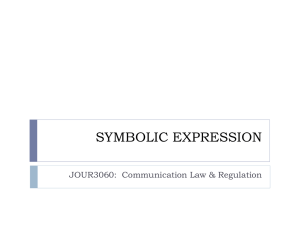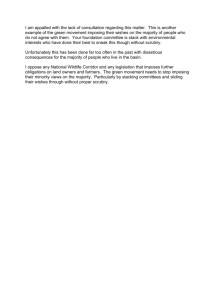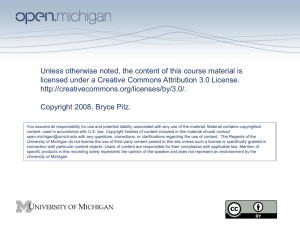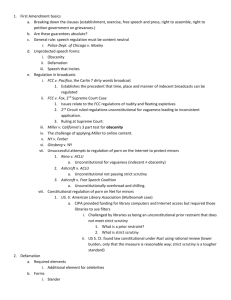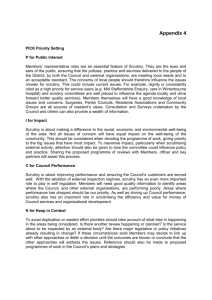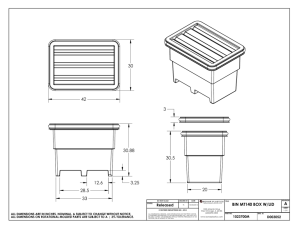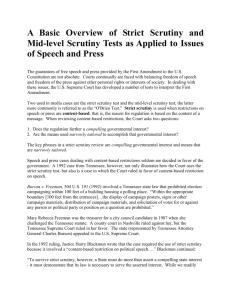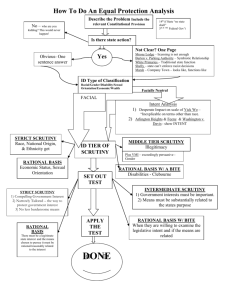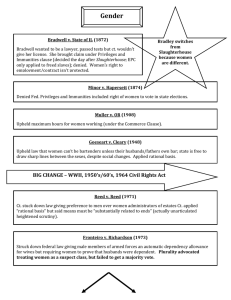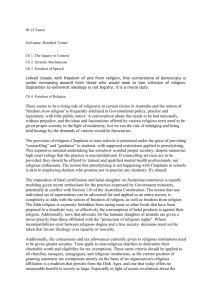notes for powers 2.26 class
advertisement
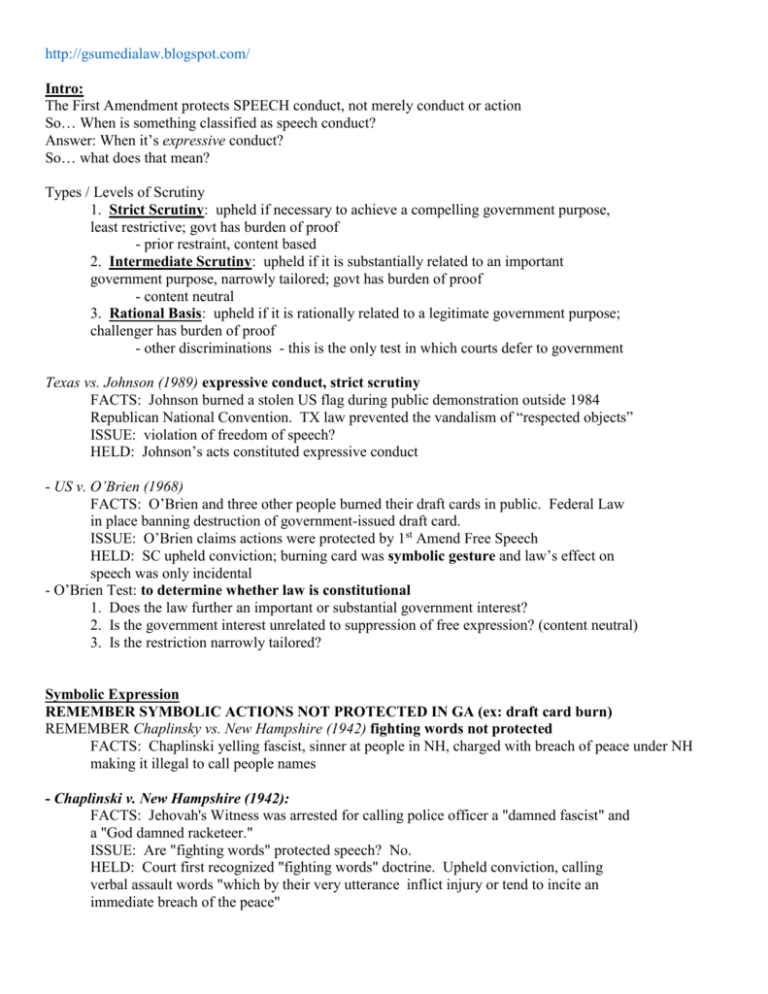
http://gsumedialaw.blogspot.com/ Intro: The First Amendment protects SPEECH conduct, not merely conduct or action So… When is something classified as speech conduct? Answer: When it’s expressive conduct? So… what does that mean? Types / Levels of Scrutiny 1. Strict Scrutiny: upheld if necessary to achieve a compelling government purpose, least restrictive; govt has burden of proof - prior restraint, content based 2. Intermediate Scrutiny: upheld if it is substantially related to an important government purpose, narrowly tailored; govt has burden of proof - content neutral 3. Rational Basis: upheld if it is rationally related to a legitimate government purpose; challenger has burden of proof - other discriminations - this is the only test in which courts defer to government Texas vs. Johnson (1989) expressive conduct, strict scrutiny FACTS: Johnson burned a stolen US flag during public demonstration outside 1984 Republican National Convention. TX law prevented the vandalism of “respected objects” ISSUE: violation of freedom of speech? HELD: Johnson’s acts constituted expressive conduct - US v. O’Brien (1968) FACTS: O’Brien and three other people burned their draft cards in public. Federal Law in place banning destruction of government-issued draft card. ISSUE: O’Brien claims actions were protected by 1st Amend Free Speech HELD: SC upheld conviction; burning card was symbolic gesture and law’s effect on speech was only incidental - O’Brien Test: to determine whether law is constitutional 1. Does the law further an important or substantial government interest? 2. Is the government interest unrelated to suppression of free expression? (content neutral) 3. Is the restriction narrowly tailored? Symbolic Expression REMEMBER SYMBOLIC ACTIONS NOT PROTECTED IN GA (ex: draft card burn) REMEMBER Chaplinsky vs. New Hampshire (1942) fighting words not protected FACTS: Chaplinski yelling fascist, sinner at people in NH, charged with breach of peace under NH making it illegal to call people names - Chaplinski v. New Hampshire (1942): FACTS: Jehovah's Witness was arrested for calling police officer a "damned fascist" and a "God damned racketeer." ISSUE: Are "fighting words" protected speech? No. HELD: Court first recognized "fighting words" doctrine. Upheld conviction, calling verbal assault words "which by their very utterance inflict injury or tend to incite an immediate breach of the peace" Terminiello vs. Chicago (1949) FACTS: Arthur Terminiello, suspended Catholic priest, giving speech to Christian Veterans of America. 800 attendees, 1000 people outside protesting. Terminiello criticized racial groups and made other inflammatory comments. Chicago PD arrest Terminiello under city’s “breach of the peace” ordinance. ISSUE: Was Terminiello’s speech protected? HELD: US SC held that Chicago’s “breach of the peace” ordinance banning speech which “stirs the public to anger, invites dispute, brings about a condition of unrest, or creates a disturbance" was unconstitutional under 1st and 14th Amendment Cohen vs. California (1971) must pass strict scrutiny FACTS: Cohen showed up to court wearing jacket with four-letter word on it. Charged with disturbing the peace. CA law prohibit “maliciously and willfully disturbing the peace or quiet of any neighborhood or person by offensive conduct” ISSUE: Did CA law violate free speech? Was jacket offensive speech or conduct HELD: SC found CA law unconstitutional; violation of 1st Amend to make public display of “expletives” a criminal offense, without a more specific and compelling reason Virginia vs. Black (2003)content-based laws are unconstitutional FACT: Black was Klan member who burned cross at rally on private property. VA law bans people from burning crosses to intimidate. Black claims trying to inspire on private property, not intimidate public. ISSUE: Did VA law violate 1st Amend rights? Content-based. HELD: Court found that the Virginia law was not constitutional because it instructed juries to find that all cross burnings were assumed to have been done with an intent to intimidate. **strict scrutiny HELD: Content based regulations did not pass scrutiny test Contrast Chaplinski with Snyder v. Phelps (2011): generally offensive language, including hateful speech at military funerals is still protected; NOT fighting words FACTS: Matthew Snyder marine killed in Iraw War. In March 2006, Fred Phelps and Phelps’ Westboro Baptist Church picketed Snyder’s funeral – in protest of increasing tolerance of homosexuality. Displayed posters reading "America is doomed", "You're going to hell", "God hates you", "Fag troops", "Semper fi fags" and "Thank God for dead soldiers". Snyder’s father, Albert, claims IIED, defamation, invasion of privacy, etc. ISSUE: Whether 1st Amend protects public protests at a funeral HELD: US SC held that speech on a public sidewalk, on public issue, cannot be liable for IIED, even if speech is “outrageous” (8-1) When is the Conduct Expressive? Test: - Is there intent to express, convey or disseminate a message? If yes, then…. - Is there a likelihood that the message will be understood? If yes, then.. First Amendment Protection - Is the governmental regulation aimed directly at the suppression of free expression, or is it aimed at regulating something else? Yes = (necessary to achieve compelling govt purpose) *Strict No = (substantially related to important govt purpose, narrowly tailored) *Immed https://hodgkisslaw.wordpress.com/2014/02/07/legal-news-is-headlight-flashing-protected-speech-missourijudge-says-yes/
